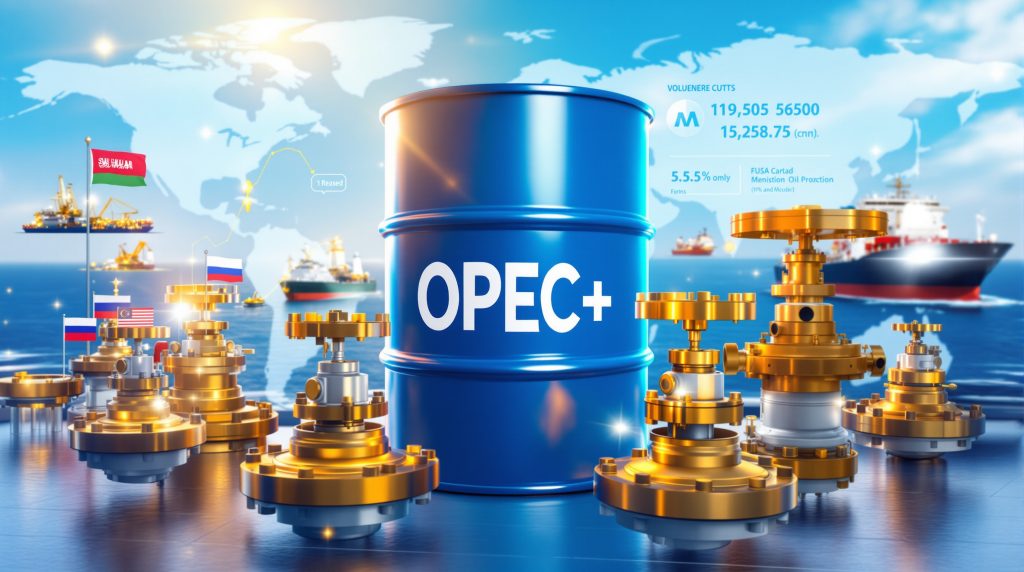Understanding OPEC+ Supply Restraint: Market Impact and Global Implications
OPEC+ supply restraint represents a critical balancing force in global energy markets, carefully managing production levels to stabilize prices and market conditions. The coalition's strategic output decisions directly impact global oil supply-demand dynamics, price volatility, and energy security worldwide.
As of September 2025, OPEC+ production reached 43.17 million barrels per day, representing approximately 55% of global oil production. This coalition controls over 90% of proven oil reserves globally, giving it significant OPEC market influence despite facing increasing challenges from non-OPEC producers.
The Evolution of OPEC+ Production Strategy
Since late 2022, OPEC+ has implemented voluntary production cuts reaching approximately 2.5 million barrels per day (b/d) by September 2025. This coordinated effort aimed to counter market oversupply concerns and support price stability during periods of economic uncertainty.
In April 2025, the coalition began a carefully calibrated unwinding process, introducing gradual monthly production increases of 137,000 b/d. This 18-month plan will ultimately return about 2.2 million b/d to the market by September 2026, with the United Arab Emirates separately raising its production target by 300,000 b/d during this period.
According to recent market data, OPEC+ production has already increased by 2.7 million barrels per day year-to-date as of October 2025, indicating that the coalition is adhering to its gradual supply return strategy while remaining cautious about oversupplying the market.
What Factors Drive OPEC+ Production Decisions?
Market Fundamentals Analysis
OPEC+ production decisions rely on comprehensive analysis of market fundamentals, including:
- Global oil demand growth projections
- Non-OPEC supply forecasts
- Inventory levels across major consuming regions
- Economic indicators from key consuming nations
- Seasonal demand patterns
- Geopolitical risk assessments
The group's technical committees meet regularly to evaluate these factors before making recommendations to ministerial meetings where final decisions are formalized.
Recent data from the U.S. Energy Information Administration (EIA) has significantly influenced OPEC+ decision-making. The EIA raised its 2025 crude production forecast to 13.53 million bpd—an all-time high—up from a prior estimate of 13.44 million. Additionally, the EIA projects global inventories will build by roughly 2 million bpd through the end of the year and into the first half of 2026, keeping pressure on prices.
Balancing Competing Member Interests
The coalition must navigate diverse economic and political priorities among its members:
| Member Country | Primary Production Objective |
|---|---|
| Saudi Arabia | Price stability and market leadership |
| Russia | Revenue maximization and market share |
| UAE | Production capacity expansion and utilization |
| Iraq | Revenue generation for economic development |
| Kuwait | Conservative production within sustainable capacity |
These divergent interests create internal tensions that occasionally surface during production negotiations, requiring diplomatic compromise to maintain coalition cohesion.
The most recent OPEC+ meeting revealed these tensions, with Saudi Arabia reportedly advocating for a more aggressive supply return to regain market share, while Russia favored a conservative approach to avoid triggering another wave of price pressure. Despite these differences, the group ultimately decided on maintaining the gradual increase of 137,000 barrels per day for November 2025.
What Is the Current State of OPEC+ Supply Restraint?
Production Compliance and Monitoring
Recent data shows OPEC+ production peaked at 43.17 million b/d in September 2025, reflecting strong overall compliance with established quotas during the initial stages of output increases. The coalition employs a sophisticated monitoring system to track member compliance, with independent secondary sources verifying production figures.
Some members have demonstrated stronger compliance than others:
- Saudi Arabia consistently maintains near-perfect adherence to targets
- Russia has shown improved compliance in recent months
- Iraq and Kazakhstan have struggled with consistent compliance
- UAE has maintained strong compliance while advocating for higher quotas
The group has implemented a compensation mechanism requiring overproducers to make additional cuts in subsequent months, though the effectiveness of this system varies.
Spare Capacity Limitations
A critical factor constraining OPEC+ flexibility is rapidly diminishing spare production capacity:
- Saudi Arabia holds approximately 1.2 million b/d of readily available spare capacity
- UAE maintains roughly 600,000 b/d of additional potential output
- Iraq retains limited spare capacity of about 300,000 b/d
- Most other members are producing near maximum sustainable capacity
This concentration of spare capacity among few members limits the coalition's ability to respond to supply disruptions and increases vulnerability to price spikes during geopolitical crises.
According to the Oxford Institute for Energy Studies, this spare capacity concentration represents a structural vulnerability in global oil markets that could amplify price volatility during supply shocks, even with seemingly adequate inventory levels.
How Does OPEC+ Supply Restraint Impact Global Oil Prices?
Price Stabilization Effects
OPEC+ production discipline has helped maintain relatively stable oil prices despite significant market uncertainties. By adjusting output in response to changing market conditions, the group provides a counterbalance to supply-demand imbalances.
The gradual unwinding of production cuts reflects what OPEC+ describes as "healthy market fundamentals and a positive market outlook." However, the coalition emphasizes that the return to higher production levels will remain "gradual and flexible," allowing for adaptive responses to evolving market conditions.
As of October 2025, light crude oil futures have settled at $61.50, up $0.62 or 1.02% for the week, with the 52-week moving average sitting at $62.96. This indicates that prices are hovering near but slightly below longer-term averages, suggesting the market remains in relative balance despite concerns about oversupply.
Market Reaction Patterns
Oil prices have shown mixed reactions to OPEC+ policy announcements:
- Initial price increases typically follow production cut announcements
- Gradual price adjustments occur as markets assess actual implementation
- Compliance levels significantly influence sustained price impacts
- External factors like U.S. inventory data often moderate price effects
- Geopolitical developments can amplify or diminish OPEC+ policy impacts
Traders carefully analyze OPEC+ statements for signals about future production intentions, creating market momentum that sometimes exceeds the direct supply impact of announced changes.
The International Energy Agency's Oil Market Report from September 2024 indicates that OPEC+ decisions typically influence prices through multiple channels: the direct supply effect (physical barrels), the expectation effect (trader positioning), the inventory effect (storage economics), and the spare capacity premium (geopolitical risk pricing).
What Are the Broader Economic Implications of OPEC+ Supply Restraint?
Impact on Global Economic Growth
OPEC+ supply restraint creates complex economic ripple effects:
- For oil-importing nations: Higher energy costs can constrain economic growth, increase inflation pressures, and reduce consumer purchasing power
- For oil-exporting nations: Price stability supports government revenues, enables fiscal planning, and sustains economic development
- For energy-intensive industries: Production costs fluctuate with energy prices, affecting competitiveness and investment decisions
- For transportation sectors: Fuel price stability influences logistics costs, travel patterns, and vehicle purchase decisions
The group's production decisions thus represent a delicate balance between supporting producer revenues and avoiding economic damage to consuming nations.
According to the International Monetary Fund's World Economic Outlook (October 2024), a sustained $10 per barrel increase in oil prices typically reduces global GDP growth by approximately 0.15 percentage points and raises global inflation by about 0.4 percentage points within the first year.
Investment Cycle Influences
OPEC+ supply management directly impacts global oil industry investment patterns:
- Price stability encourages capital expenditure in new production
- Predictable market conditions support long-term project planning
- Supply restraint prevents price collapses that could trigger investment freezes
- Gradual policy shifts allow industry adaptation without market shocks
By moderating boom-bust cycles, OPEC+ policy can theoretically support more sustainable industry development, though critics argue it artificially distorts market signals.
Recent evidence of this impact can be seen in the industry's response to lower oil prices. Major companies including Chevron, BP, and TotalEnergies have all reduced share buybacks, citing payout strategies that are unsustainable below $80 Brent. TotalEnergies also announced $7.5 billion in cost cuts, highlighting the margin squeeze facing the industry in the current price environment.
How Does OPEC+ Supply Restraint Compare to Historical Approaches?
Evolution of Coordination Mechanisms
OPEC+ represents a significant evolution from earlier oil market management approaches:
- 1960s-1970s: OPEC focused on securing producer sovereignty and maximizing government take
- 1980s-1990s: Production quotas emerged as the primary coordination mechanism
- 2000s: Price band targets guided production decisions
- 2010s: OPEC+ formation expanded coordination to include Russia and other non-OPEC producers
- 2020s: Pandemic response demonstrated unprecedented flexibility in production management
The current approach reflects lessons learned from previous market interventions, with greater emphasis on data-driven decisions and adaptive responses to market conditions.
The Declaration of Cooperation between OPEC and non-OPEC producing countries was signed on December 10, 2016, in Vienna, marking the formal beginning of the OPEC+ alliance. The agreement initially involved production cuts of 1.8 million b/d (1.2 million b/d from OPEC and 0.6 million b/d from non-OPEC partners).
Technological and Market Structure Changes
Today's OPEC+ operates in a fundamentally transformed market environment:
- US drilling decline provides a responsive supply counterbalance
- Financial markets offer sophisticated hedging mechanisms
- Digital technologies enable real-time monitoring of global oil movements
- Energy transition pressures create long-term demand uncertainties
- Strategic petroleum reserves provide consumer nations with response options
These structural changes have required OPEC+ to adopt more nuanced and flexible approaches to market management compared to earlier eras.
According to the Federal Reserve Bank of Dallas Energy Survey (Q3 2024), U.S. shale producers typically require 6-9 months to significantly increase production in response to higher prices, with breakeven costs ranging from $40-$65 per barrel across major basins. This response lag gives OPEC+ a window for market intervention before non-OPEC supply fully responds.
What Challenges Does OPEC+ Face in Maintaining Supply Restraint?
Compliance and Cohesion Challenges
The coalition faces ongoing challenges in maintaining production discipline:
- Economic pressures tempt members to exceed quotas for additional revenue
- Political tensions between key members occasionally threaten cooperation
- Technical production constraints create uneven compliance capabilities
- Compensation mechanisms for overproduction lack strong enforcement
- New capacity additions create pressure for higher quota allocations
These internal dynamics require continuous diplomatic effort to maintain coalition effectiveness and prevent fragmentation.
External Market Pressures
OPEC+ must navigate significant external challenges:
- Rapid U.S. production growth undermines market share
- Energy transition policies create long-term demand uncertainties
- Strategic petroleum reserve releases can temporarily counteract supply restraint
- Sanctions on member countries complicate production coordination
- Global economic volatility makes demand forecasting increasingly difficult
The coalition's ability to adapt to these external pressures will determine its long-term relevance and effectiveness.
Recent geopolitical developments further complicate the picture. In October 2025, a reported drone strike and fire at Russia's Kirishi refinery forced the shutdown of its top distillation unit. The incident is expected to halt operations for up to a month, sidelining meaningful output. Additionally, a ceasefire agreement between Israel and Hamas introduced a potential easing of geopolitical tensions in the Middle East.
What Is the Future Outlook for OPEC+ Supply Restraint?
Short-Term Production Trajectory
The U.S. Energy Information Administration (EIA) forecasts that increased OPEC+ production, alongside significant growth from non-OPEC+ producers, will contribute to rising global oil inventories through 2026. This inventory buildup is expected to exert downward pressure on prices, with Brent crude projected to average $62 per barrel in late 2025 and potentially decline further in 2026.
OPEC+ will likely need to carefully calibrate its unwinding schedule against these inventory trends, potentially slowing or pausing production increases if market conditions deteriorate more rapidly than anticipated.
Adding to potential oversupply concerns, China is expanding its strategic petroleum reserve, with plans to add 169 million barrels of storage capacity across 11 new sites operated by state firms such as Sinopec and PetroChina. Though officially classified as commercial, these reserves are widely seen as part of Beijing's emergency stockpiling strategy and may impact global demand-supply balances.
Long-Term Strategic Considerations
Looking beyond immediate market management, OPEC+ faces profound strategic questions:
- How to maintain relevance amid accelerating energy transition
- Whether to prioritize market share or price stability
- How to incorporate renewable energy into member economic strategies
- When to maximize remaining hydrocarbon asset value
- How to manage declining long-term demand scenarios
These existential questions will shape the coalition's approach to supply restraint in coming years, potentially leading to more fundamental strategy shifts.
According to the International Energy Agency's Net Zero by 2050 Scenario (updated October 2024), global oil demand would need to decline from approximately 102 million b/d in 2024 to around 55 million b/d by 2035 and to 24 million b/d by 2050 to achieve net-zero emissions targets. This trajectory poses an existential challenge to OPEC+ members whose economies remain heavily dependent on oil revenue.
How Should Investors and Market Participants Interpret OPEC+ Actions?
Key Monitoring Indicators
Market participants should focus on several key indicators when evaluating OPEC+ policy impacts:
- Actual production data versus announced targets
- Meeting statements and technical committee reports
- Public comments from key member ministers
- Inventory trends in major consuming regions
- Spare capacity levels among core producers
- Demand forecast revisions from major agencies
- Non-OPEC supply growth rates in key regions
These indicators provide early signals of potential policy shifts and effectiveness of current approaches.
In technical trading terms, market analysis should consider key price levels. With light crude futures at $61.50, the 52-week moving average at $62.96 represents a significant technical hurdle. A sustained move above this level could signal renewed buying interest, potentially targeting the long-term 50% level at $64.21, while failure to break above it could send prices back toward the 61.8% Fibonacci level at $59.91.
Strategic Response Considerations
Different market participants require tailored approaches to OPEC+ developments:
- Producers: Hedge production at favorable price points; align investment cycles with OPEC+ policy shifts
- Consumers: Diversify supply sources; maintain strategic reserves; develop demand flexibility
- Traders: Monitor compliance data; analyze technical committee reports; track tanker movements
- Investors: Evaluate company exposure to price volatility; assess geographic diversification; consider energy transition positioning
Understanding OPEC+ dynamics provides strategic advantages in navigating energy market complexity.
In the current environment, with price levels below $80 per barrel, energy investors should carefully evaluate corporate capital allocation policies. The recent moves by majors to reduce share buybacks and implement cost-cutting measures indicate that balance sheet protection is becoming a priority, potentially at the expense of shareholder returns in the short term.
FAQ: OPEC+ Supply Restraint
What is the difference between OPEC and OPEC+?
OPEC (Organization of the Petroleum Exporting Countries) consists of 13 member nations including Saudi Arabia, Iraq, Iran, and the UAE. OPEC+ expands this group to include 10 additional non-OPEC producers, most notably Russia, Kazakhstan, and Mexico. This expanded coalition represents approximately 55% of global oil production and over 90% of proven oil reserves.
How do OPEC+ production cuts actually work?
OPEC+ establishes baseline production levels for each member country, then agrees on percentage reductions from these baselines. Each country receives a specific production target, which they are expected to implement through their national oil companies or by directing private producers within their borders. Compliance is monitored through both self-reporting and independent secondary sources.
According to OPEC's official procedures, the Joint Ministerial Monitoring Committee (JMMC) typically meets monthly or bi-monthly to review market conditions and compliance. The full OPEC+ ministerial conference convenes semi-annually, with extraordinary meetings called when market conditions warrant.
Why doesn't OPEC+ simply cut enough production to push prices higher?
Several factors constrain OPEC+'s ability to aggressively cut production:
- Higher prices incentivize non-OPEC production growth
- Excessive cuts risk permanent market share loss
- Very high prices accelerate energy transition and demand destruction
- Internal member disagreements limit extreme policy actions
- Geopolitical considerations with consuming nations influence decisions
The group seeks a balance that supports reasonable prices while maintaining long-term market relevance.
How does U.S. shale production influence OPEC+ strategy?
U.S. shale production represents a responsive counterbalance to OPEC+ actions, typically increasing when prices rise and contracting when prices fall. This elasticity limits OPEC+'s market power and forces more moderate approaches to supply management. The coalition must constantly evaluate U.S. production trends when calibrating its own output decisions.
The EIA's recent upward revision of U.S. production to 13.53 million barrels per day for 2025 represents an all-time high, demonstrating the continued resilience of the U.S. shale sector despite lower price environments. This sustained growth in non-OPEC+ production remains a significant challenge to OPEC+'s market management strategy.
Further Exploration
Readers interested in learning more about global oil market dynamics can also explore related educational content, such as Oilprice.com's analysis of "Cautious OPEC+ Strategy Offsets U.S. Output Boom." This article offers another perspective on the interplay between OPEC+ production decisions and global market factors.
It's important to note that the oil market remains in flux, with numerous factors potentially impacting prices in the coming months. Inventory buildups, geopolitical developments, economic growth trajectories, and trade war oil movements will all play crucial roles in determining both OPEC+ strategy and broader market outcomes. Furthermore, the tariff impact on oil prices and fluctuations in WTI & Brent futures continue to shape this complex global marketplace.
Ready to Trade Ahead of Major Market Movements?
Discovery Alert's proprietary Discovery IQ model provides instant notifications on significant ASX mineral discoveries, helping investors identify actionable opportunities before the broader market. Visit the Discovery Alert discoveries page to understand how major mineral findings can lead to substantial returns, and begin your 30-day free trial today.




